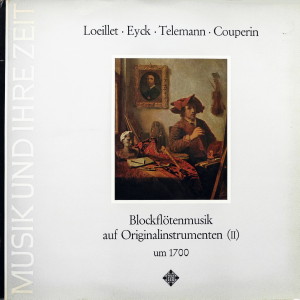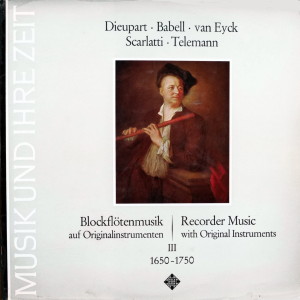 |
1 LP -
Telefunken 6.42811 AP (p) 1969/1972
|
|
| ORIGINALINSTRUMENTE - Blockflöte
· Recorder · Flûte à bec |
|
|
|
|
|
|
|
| Jean Baptiste Loeillet (1680-1730) |
Sonate
G-dur für Blockflöte und B.c.
*
|
|
10' 37" |
A1 |
|
-
Largo · Allegro · Adagio · Gavotta |
|
|
|
| François Dieupart
(um 1670 - um 1740) |
Suite
A-dur für Blockflöte und B.c.
**
|
|
17' 43" |
A2 |
|
-
Ouverture · Allemande · Courante ·
Sarabande · Gavotte · Menuett ·
Gigue |
|
|
|
| François Couperin
(1668-1733) |
Le
Rossignol en amour - aus
"Pièces de clavecin" Livre 3, 1722,
Quatorzième Ordre ***
|
|
7' 25" |
B1 |
| Georg
Philipp Telemann (1681-1767)
|
Fantasie
B-dur, für
Blockflöte solo ****
|
|
3' 47" |
B2 |
|
-
Allegro · Adagio · Vivace · Allegro |
|
|
|
|
Fantasie
g-moll, für
Blockflöte solo
****
|
|
4' 38" |
B3 |
|
-
Largo · Spirituoso · Allegro |
|
|
|
| William Babell (um
1690 - 1723) |
Concerto
à 7 D-dur für Blockflöte,
Streicher und B.c. *****
|
|
9' 14" |
B4 |
|
-
Allegro · Adagio · Allegro |
|
|
|
|
|
|
|
|
| Frans
BRÜGGEN |
mit |
|
-
Altblockflöte in f' von J. Denner,
Nürnberg *
|
Marie
Leonhardt, Violine
***** |
|
-
Blockflöte in d' (voice flute) von
P. I. Bressan, London, um 1720
**
|
Alda
Stuurop, Violine *****
|
|
-
Sopranino-Blockflöte in f' von J.
Denner, Nürnberg, um 1700 ***
|
Antoinette
van den Hombergh, Violine
***** |
|
-
Altblockflöte in f' von Thomas
Stanesby, London, um 1700 ****
|
Lucy
van Dael, Violine
***** |
|
-
Blockflöte in d" (sixth flute) von
Thomas Stanesby jr., London, ca.
1730 *****
|
Anner
Bylsma, Violoncello
*/**/***** |
|
|
Fred
Nijenhuis, kontrabaß
***** |
|
|
Gustav
Leonhardt, Violoncello
*/**/***** |
|
|
|
|
|
Luogo
e data di registrazione |
|
Bennebroek
(Olanda) - aprile e maggio 1969
(Loeillet, Couperin)
Doopsgezinde Kerk, Amsterdam
(Olanda) - gennaio e novembre 1971
(Dieupart, Telemann, Babell)
|
|
|
Registrazione:
live / studio |
|
studio |
|
|
Recording
Supervision
|
|
-
|
|
|
Edizione LP |
|
TELEFUNKEN
- 6.42811 AP - (1 LP - durata 53'
24") - (p) 1969 */*** & 1972 -
Analogico
|
|
|
Originale LP
|
|
TELEFUNKEN - SAWT
9545-A - (1 LP - durata 41' 45")
- (p) 1969 - Analogico
(Loeillet, Couperin)
TELEFUNKEN - SAWT 9582-A - (1 LP
- durata 52' 43") - (p) 1972 -
Analogico (Dieupart, Telemann,
Babell)
|
|
|
Prima Edizione CD |
|
TELDEC "Frans
Brüggen Edition" Vol. 12 -
4509-97474-2 - (1 CD - durata
68' 46") - (c) 1995 - ADD
(Loeillet)
TELDEC "Frans
Brüggen Edition" Vol. 6 -
4509-97468-2 - (1 CD -
durata 47' 52") - (c) 1995 -
ADD (Dieupart)
TELDEC
"Frans Brüggen Edition"
Vol. 7 - 4509-97469-2 -
(1 CD - durata 44' 46")
- (c) 1995 - ADD
(Couperin)
TELDEC
"Frans Brüggen
Edition" Vol. 1 -
4509-93688-2 - (1 CD
- durata 74' 44") -
(c) 1995 - ADD
(Telemann)
TELDEC
"Frans Brüggen
Edition" Vol. 3
- 4509-97465-2 -
(1 CD - durata
64' 20") - (c)
1995 - ADD
(Babell)
|
|
|
Note |
|
Long
playing compilation.
|
|
|
|
|
  |
From the
host of recorder
makers of the late
seventeenth and
early eighteenth
centuries, three
stand out
strongly, firstly
because of the
opinion of their
contemporaries,
and secondly
because of the
quality of their
instruments. These
three are Peter
Bressan, Thomas
Stanesby Senior
and Junior, and
the Denners,
father and son,
Many surviving
examples of their
work are known to
present day
players and
makers, and while
relatively few of
these instruments
are still in good
playing order,
those that are
suggest that they
can hardly be
surpassed, whether
for workmanship,
quality of sound,
intonation,
playing behaviour,
or durability.
The two
instruments by
Denner are both
remarkable in
their form. The
treble instrument
has an unusually
sharply
contracting bore,
and combines firm
and easy low notes
with a broad,
clear und
easy-speaking high
register. The
sopranino, made of
ivory, has a
windway which is
relatively large
for so small an
instrument, but
which results in a
sound of clarity,
breadth and
openness. This
makes it effective
and easy to listen
to despite its
high pitch.
The voice flute
(in d') by Bressan
is an instrument
which is rather
mysterious to us
today. While there
are several pieces
which specify the
voice flute in
their
instrumentation,
these hardly
constitute a
repertoire which
can account for
the number of
examples of voice
flutes surviving.
The works by
Dieupart calling
for voice flute
demand a compass
of only one octave
and a sixth, and
the quintet by
Loeillet asks for
only one note
more. Of four
Bressan voice
flutes in
collections in
England and
Holland, all have
a range of one
octave and a
seventh, perfect
for this small
repertoire, but
surprising by
comparison with
Bressan’s other
recorders, tenors
and trebles, with
their wide compass
and strong tone.
The physical
reason for the
smaller range lies
in the placing of
the lower tone
holes, which does
result in a
slightly easier
reach for the
hand, but
concerning
Bressan’s reasons
for so placing
these holes we are
at present
ignorant. A
possibility is the
extremely firm 2nd
and 3rd notes (e'
and f'sharp) which
also result from
the hole spacing.
Perhaps one day it
will be possible
to be certain; in
the meantime,the
Bressan voice
flutes have a
quality of
soundwhich
compensates us for
the smaller range,
and which may in
itself` have been
Bressan’s reason
for making these
instruments.
The treble in f'
and the sixth
flute in d' by the
Stanesbys are
beautiful examples
of the English
school of recorder
making. While they
are essentially
similar to
instruments by
Bressan, Bradbury,
and Urquhart, they
nonetheless show
characteristics
peculiar to the
Stanesbys in both
voicing and
external profile.
The treble is
remarkable for its
evenness of tone
right down its low
f', and the
balance of its
registers across
the whole range.
In particular the
fulness and ease
of the hight e'''
and f''' can be
regarded as
especially
characteristic of
the Stanesbys and
Bressan at their
very best. The
sixth flute, so
called because it
is six notes
higher than the
concert flute
(treble in f'),
had many concertos
written for it by
Babell, Baston,
Woodcock, and
other English
composers. The
instrument played
here is in ivory,
very full and
fmely carved with
a Cupid’s face,
grapes, vine
leaves, and other
floral motifs. Its
sound matches the
quality of its
decoration, being
very clear,
flexible, and, for
a recorder,
strong.
Frederick
Morgan
|
|
|
|

